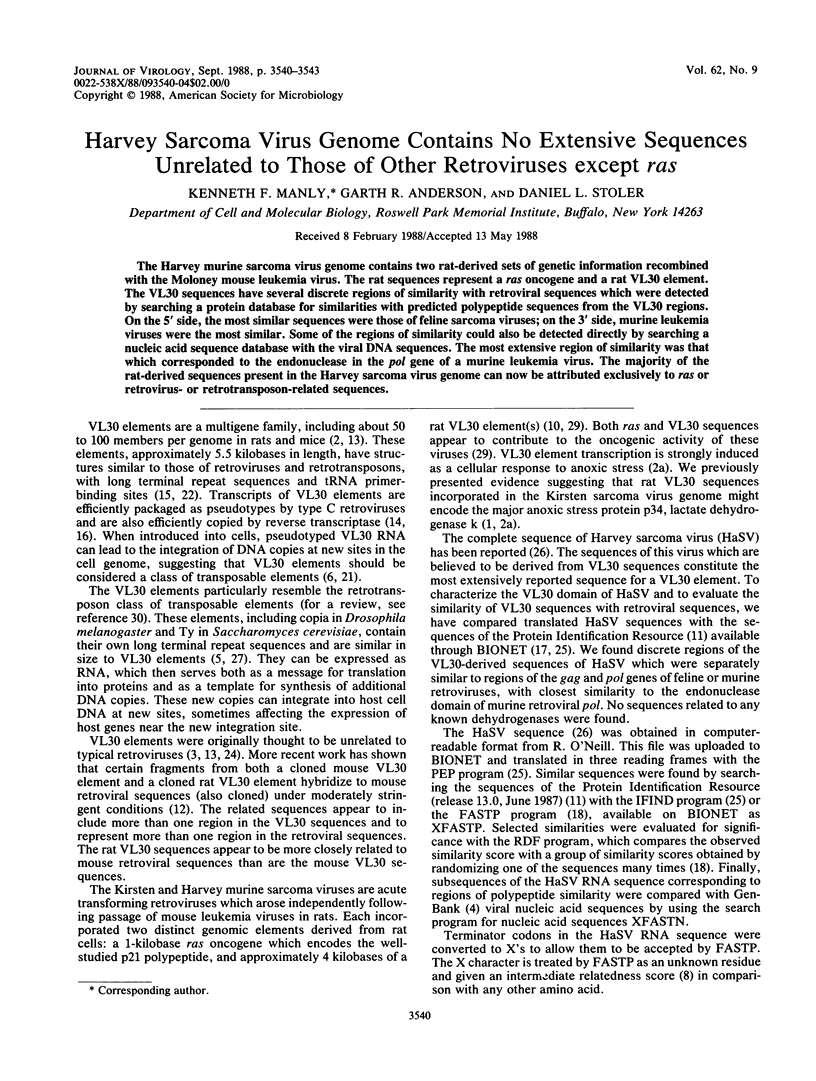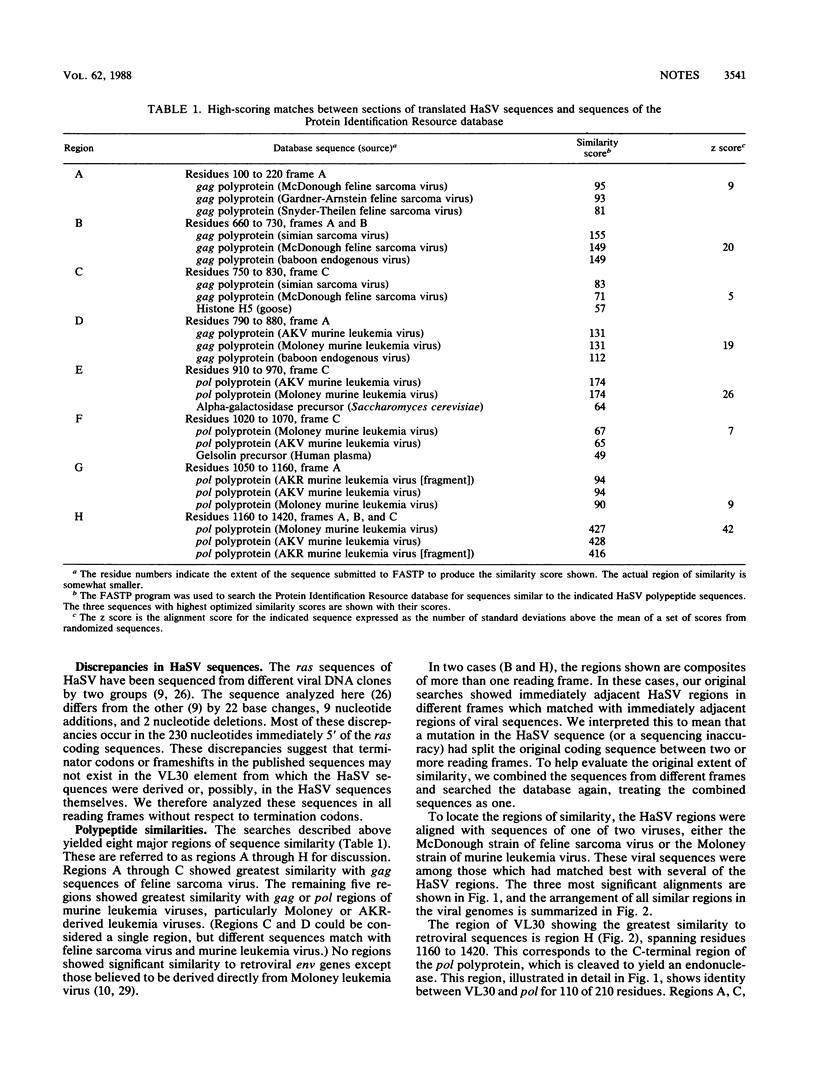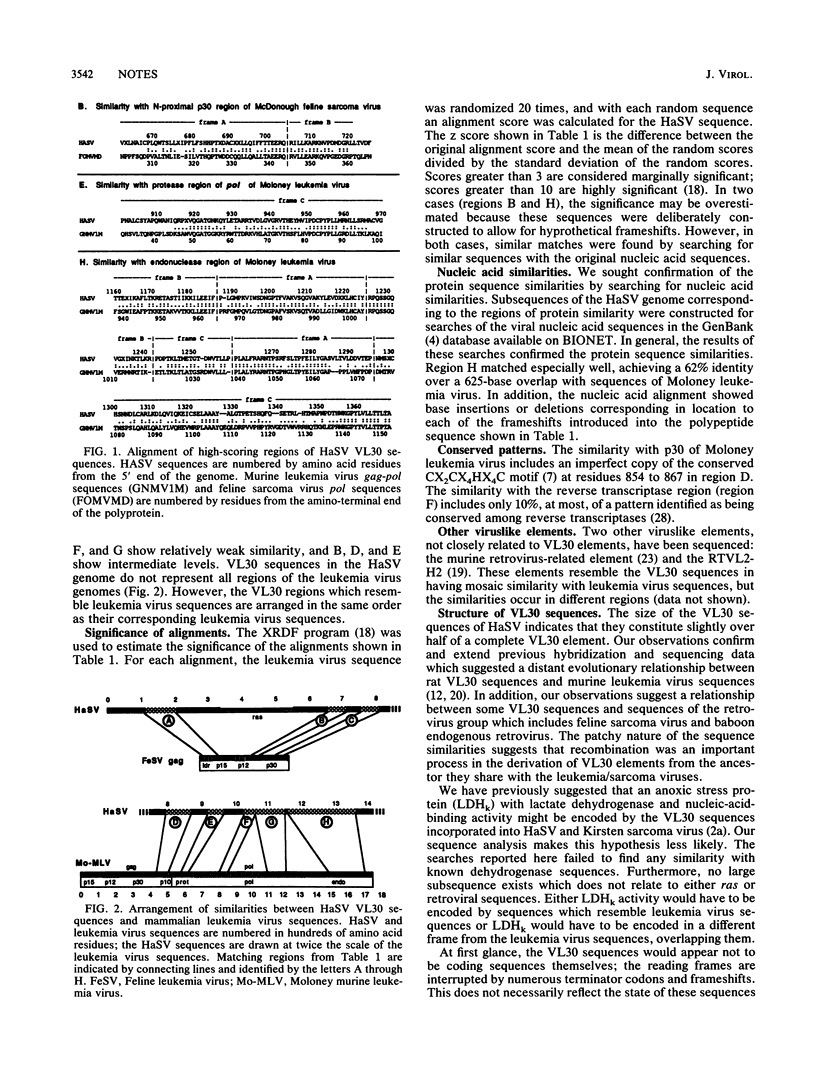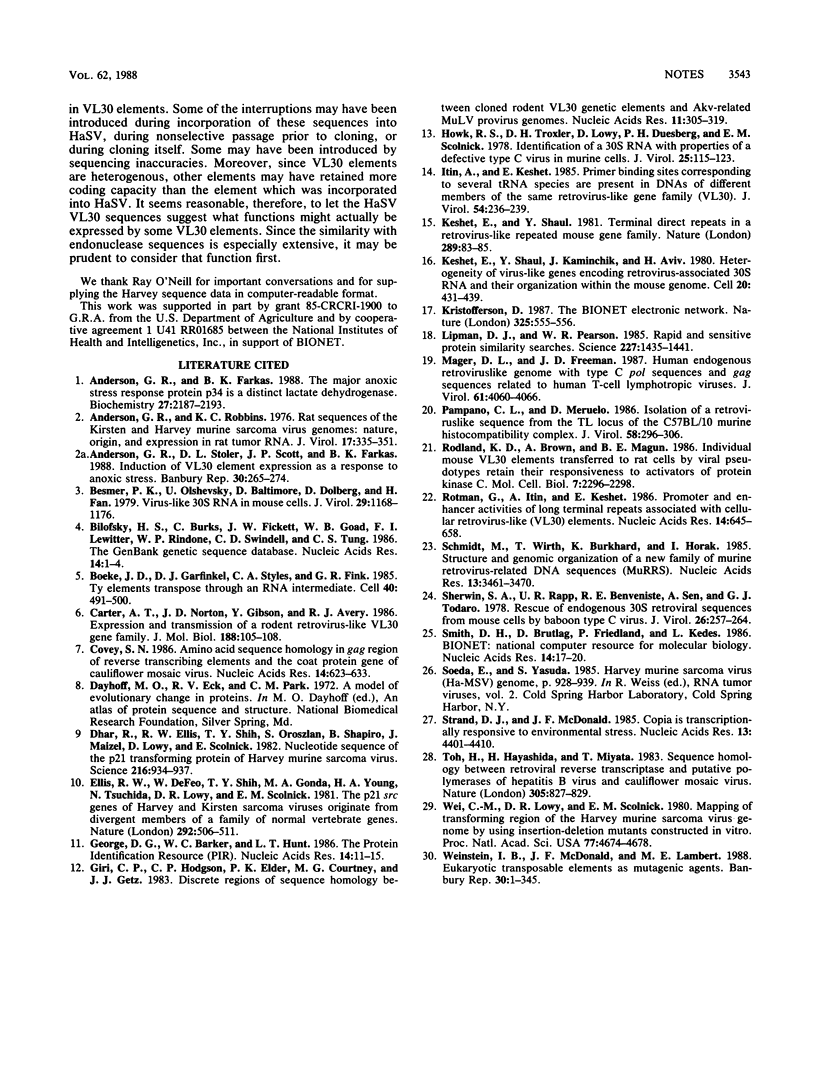Abstract
The Harvey murine sarcoma virus genome contains two rat-derived sets of genetic information recombined with the Moloney mouse leukemia virus. The rat sequences represent a ras oncogene and a rat VL30 element. The VL30 sequences have several discrete regions of similarity with retroviral sequences which were detected by searching a protein database for similarities with predicted polypeptide sequences from the VL30 regions. On the 5' side, the most similar sequences were those of feline sarcoma viruses; on the 3' side, murine leukemia viruses were the most similar. Some of the regions of similarity could also be detected directly by searching a nucleic acid sequence database with the viral DNA sequences. The most extensive region of similarity was that which corresponded to the endonuclease in the pol gene of a murine leukemia virus. The majority of the rat-derived sequences present in the Harvey sarcoma virus genome can now be attributed exclusively to ras or retrovirus- or retrotransposon-related sequences.
Full text
PDF



Selected References
These references are in PubMed. This may not be the complete list of references from this article.
- Anderson G. R., Farkas B. K. The major anoxic stress response protein p34 is a distinct lactate dehydrogenase. Biochemistry. 1988 Mar 22;27(6):2187–2193. doi: 10.1021/bi00406a056. [DOI] [PubMed] [Google Scholar]
- Anderson G. R., Robbins K. C. Rat sequences of the Kirsten and Harvey murine sarcoma virus genomes: nature, origin, and expression in rat tumor RNA. J Virol. 1976 Feb;17(2):335–351. doi: 10.1128/jvi.17.2.335-351.1976. [DOI] [PMC free article] [PubMed] [Google Scholar]
- Besmer P., Olshevsky U., Baltimore D., Dolberg D., Fan H. Virus-like 30S RNA in mouse cells. J Virol. 1979 Mar;29(3):1168–1176. doi: 10.1128/jvi.29.3.1168-1176.1979. [DOI] [PMC free article] [PubMed] [Google Scholar]
- Bilofsky H. S., Burks C., Fickett J. W., Goad W. B., Lewitter F. I., Rindone W. P., Swindell C. D., Tung C. S. The GenBank genetic sequence databank. Nucleic Acids Res. 1986 Jan 10;14(1):1–4. doi: 10.1093/nar/14.1.1. [DOI] [PMC free article] [PubMed] [Google Scholar]
- Boeke J. D., Garfinkel D. J., Styles C. A., Fink G. R. Ty elements transpose through an RNA intermediate. Cell. 1985 Mar;40(3):491–500. doi: 10.1016/0092-8674(85)90197-7. [DOI] [PubMed] [Google Scholar]
- Carter A. T., Norton J. D., Gibson Y., Avery R. J. Expression and transmission of a rodent retrovirus-like (VL30) gene family. J Mol Biol. 1986 Mar 5;188(1):105–108. doi: 10.1016/0022-2836(86)90485-7. [DOI] [PubMed] [Google Scholar]
- Covey S. N. Amino acid sequence homology in gag region of reverse transcribing elements and the coat protein gene of cauliflower mosaic virus. Nucleic Acids Res. 1986 Jan 24;14(2):623–633. doi: 10.1093/nar/14.2.623. [DOI] [PMC free article] [PubMed] [Google Scholar]
- Dhar R., Ellis R. W., Shih T. Y., Oroszlan S., Shapiro B., Maizel J., Lowy D., Scolnick E. Nucleotide sequence of the p21 transforming protein of Harvey murine sarcoma virus. Science. 1982 Sep 3;217(4563):934–936. doi: 10.1126/science.6287572. [DOI] [PubMed] [Google Scholar]
- Ellis R. W., Defeo D., Shih T. Y., Gonda M. A., Young H. A., Tsuchida N., Lowy D. R., Scolnick E. M. The p21 src genes of Harvey and Kirsten sarcoma viruses originate from divergent members of a family of normal vertebrate genes. Nature. 1981 Aug 6;292(5823):506–511. doi: 10.1038/292506a0. [DOI] [PubMed] [Google Scholar]
- George D. G., Barker W. C., Hunt L. T. The protein identification resource (PIR). Nucleic Acids Res. 1986 Jan 10;14(1):11–15. doi: 10.1093/nar/14.1.11. [DOI] [PMC free article] [PubMed] [Google Scholar]
- Giri C. P., Hodgson C. P., Elder P. K., Courtney M. G., Getz M. J. Discrete regions of sequence homology between cloned rodent VL30 genetic elements and AKV-related MuLV provirus genomes. Nucleic Acids Res. 1983 Jan 25;11(2):305–319. doi: 10.1093/nar/11.2.305. [DOI] [PMC free article] [PubMed] [Google Scholar]
- Howk R. S., Troxler D. H., Lowy D., Duesberg P. H., Scolnick E. M. Identification of a 30S RNA with properties of a defective type C virus in murine cells. J Virol. 1978 Jan;25(1):115–123. doi: 10.1128/jvi.25.1.115-123.1978. [DOI] [PMC free article] [PubMed] [Google Scholar]
- Itin A., Keshet E. Primer binding sites corresponding to several tRNA species are present in DNAs of different members of the same retrovirus-like gene family (VL30). J Virol. 1985 Apr;54(1):236–239. doi: 10.1128/jvi.54.1.236-239.1985. [DOI] [PMC free article] [PubMed] [Google Scholar]
- Keshet E., Shaul Y., Kaminchik J., Aviv H. Heterogeneity of "virus-like" genes encoding retrovirus-associated 30S RNA and their organization within the mouse genome. Cell. 1980 Jun;20(2):431–439. doi: 10.1016/0092-8674(80)90629-7. [DOI] [PubMed] [Google Scholar]
- Keshet E., Shaul Y. Terminal direct repeats in a retrovirus-like repeated mouse gene family. Nature. 1981 Jan 1;289(5793):83–85. doi: 10.1038/289083a0. [DOI] [PubMed] [Google Scholar]
- Lipman D. J., Pearson W. R. Rapid and sensitive protein similarity searches. Science. 1985 Mar 22;227(4693):1435–1441. doi: 10.1126/science.2983426. [DOI] [PubMed] [Google Scholar]
- Mager D. L., Freeman J. D. Human endogenous retroviruslike genome with type C pol sequences and gag sequences related to human T-cell lymphotropic viruses. J Virol. 1987 Dec;61(12):4060–4066. doi: 10.1128/jvi.61.12.4060-4066.1987. [DOI] [PMC free article] [PubMed] [Google Scholar]
- Pampeno C. L., Meruelo D. Isolation of a retroviruslike sequence from the TL locus of the C57BL/10 murine major histocompatibility complex. J Virol. 1986 May;58(2):296–306. doi: 10.1128/jvi.58.2.296-306.1986. [DOI] [PMC free article] [PubMed] [Google Scholar]
- Rodland K. D., Brown A. M., Magun B. E. Individual mouse VL30 elements transferred to rat cells by viral pseudotypes retain their responsiveness to activators of protein kinase C. Mol Cell Biol. 1987 Jun;7(6):2296–2298. doi: 10.1128/mcb.7.6.2296. [DOI] [PMC free article] [PubMed] [Google Scholar]
- Rotman G., Itin A., Keshet E. Promoter and enhancer activities of long terminal repeats associated with cellular retrovirus-like (VL30) elements. Nucleic Acids Res. 1986 Jan 24;14(2):645–658. doi: 10.1093/nar/14.2.645. [DOI] [PMC free article] [PubMed] [Google Scholar]
- Schmidt M., Wirth T., Kröger B., Horak I. Structure and genomic organization of a new family of murine retrovirus-related DNA sequences (MuRRS). Nucleic Acids Res. 1985 May 24;13(10):3461–3470. doi: 10.1093/nar/13.10.3461. [DOI] [PMC free article] [PubMed] [Google Scholar]
- Sherwin S. A., Rapp U. R., Benveniste R. E., Sen A., Todaro G. J. Rescue of endogenous 30S retroviral sequences from mouse cells by baboon type C virus. J Virol. 1978 May;26(2):257–264. doi: 10.1128/jvi.26.2.257-264.1978. [DOI] [PMC free article] [PubMed] [Google Scholar]
- Smith D. H., Brutlag D., Friedland P., Kedes L. H. BIONET: national computer resource for molecular biology. Nucleic Acids Res. 1986 Jan 10;14(1):17–20. doi: 10.1093/nar/14.1.17. [DOI] [PMC free article] [PubMed] [Google Scholar]
- Strand D. J., McDonald J. F. Copia is transcriptionally responsive to environmental stress. Nucleic Acids Res. 1985 Jun 25;13(12):4401–4410. doi: 10.1093/nar/13.12.4401. [DOI] [PMC free article] [PubMed] [Google Scholar]
- Toh H., Hayashida H., Miyata T. Sequence homology between retroviral reverse transcriptase and putative polymerases of hepatitis B virus and cauliflower mosaic virus. 1983 Oct 27-Nov 2Nature. 305(5937):827–829. doi: 10.1038/305827a0. [DOI] [PubMed] [Google Scholar]
- Wei C. M., Lowy D. R., Scolnick E. M. Mapping of transforming region of the Harvey murine sarcoma virus genome by using insertion-deletion mutants constructed in vitro. Proc Natl Acad Sci U S A. 1980 Aug;77(8):4674–4678. doi: 10.1073/pnas.77.8.4674. [DOI] [PMC free article] [PubMed] [Google Scholar]


